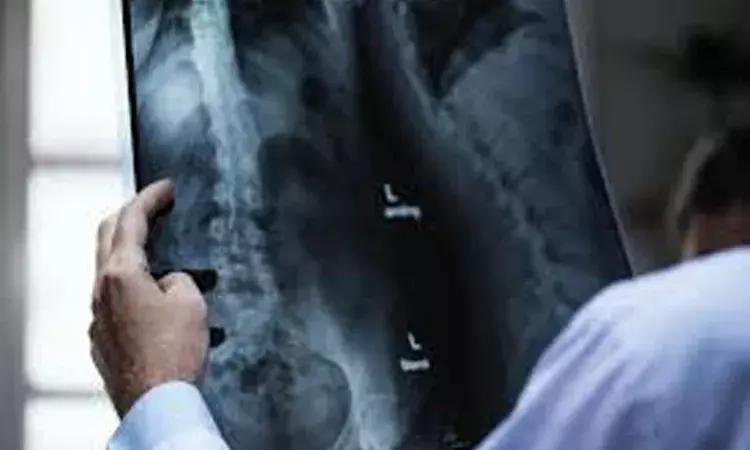- Home
- Medical news & Guidelines
- Anesthesiology
- Cardiology and CTVS
- Critical Care
- Dentistry
- Dermatology
- Diabetes and Endocrinology
- ENT
- Gastroenterology
- Medicine
- Nephrology
- Neurology
- Obstretics-Gynaecology
- Oncology
- Ophthalmology
- Orthopaedics
- Pediatrics-Neonatology
- Psychiatry
- Pulmonology
- Radiology
- Surgery
- Urology
- Laboratory Medicine
- Diet
- Nursing
- Paramedical
- Physiotherapy
- Health news
- Fact Check
- Bone Health Fact Check
- Brain Health Fact Check
- Cancer Related Fact Check
- Child Care Fact Check
- Dental and oral health fact check
- Diabetes and metabolic health fact check
- Diet and Nutrition Fact Check
- Eye and ENT Care Fact Check
- Fitness fact check
- Gut health fact check
- Heart health fact check
- Kidney health fact check
- Medical education fact check
- Men's health fact check
- Respiratory fact check
- Skin and hair care fact check
- Vaccine and Immunization fact check
- Women's health fact check
- AYUSH
- State News
- Andaman and Nicobar Islands
- Andhra Pradesh
- Arunachal Pradesh
- Assam
- Bihar
- Chandigarh
- Chattisgarh
- Dadra and Nagar Haveli
- Daman and Diu
- Delhi
- Goa
- Gujarat
- Haryana
- Himachal Pradesh
- Jammu & Kashmir
- Jharkhand
- Karnataka
- Kerala
- Ladakh
- Lakshadweep
- Madhya Pradesh
- Maharashtra
- Manipur
- Meghalaya
- Mizoram
- Nagaland
- Odisha
- Puducherry
- Punjab
- Rajasthan
- Sikkim
- Tamil Nadu
- Telangana
- Tripura
- Uttar Pradesh
- Uttrakhand
- West Bengal
- Medical Education
- Industry
Artificial intelligence may help identify osteoporosis in X-rays of patients with broken bones

WASHINGTON--Artificial intelligence that can "read" electronic radiology reports and flag patients with broken bones who are at risk of osteoporosis outperformed the traditional manual method of health care professionals reading X-ray reports, a new study finds.
The results were accepted for presentation at ENDO 2020, the Endocrine Society's annual meeting, and will be published in a special supplemental section of the Journal of the Endocrine Society.
The new search tool, called X-Ray Artificial Intelligence Tool (XRAIT), detected an almost fivefold higher number of major fractures, or bone breaks, in X-ray and computed tomography (CT) reports compared with manual methods, researchers from Australia reported.
"With XRAIT, limited health care resources can be optimized to manage the patients identified as at risk rather than used on the identification process itself," said study co-investigator Jacqueline Center, M.B.B.S., Ph.D., F.R.A.C.P. Center is head of the Clinical Studies and Epidemiology Lab at Garvan Institute of Medical Research in Sydney, Australia. "By improving identification of patients needing osteoporosis treatment or prevention, XRAIT may help reduce the risk of a second fracture and the overall burden of illness and death from osteoporosis."
About 44 million Americans--mostly women--are at risk of the bone-weakening disease osteoporosis and have an increased risk of fractures because of low bone mass, according to the Hormone Health Network. Only 2 in 10 older women in the United States who sustain a fracture receive testing or treatment for osteoporosis, the National Osteoporosis Foundation reports.
Although many hospitals have implemented fracture liaison services to identify patients whose fractures could be due to osteoporosis, Center said that manually reading the radiology records of referred patients misses some people at risk of osteoporosis or detects them too slowly.
XRAIT speeds the process using natural language processing software to "understand" human language. In this study, XRAIT searched 5,089 digital radiology reports from patients over 50 years of age who went to a hospital's emergency department and had bone imaging over three months. The researchers--led by senior author Christopher White, M.B.B.S., Ph.D., F.R.A.C.P., of Prince of Wales Hospital in Randwick, Australia--compared XRAIT's results with manual review of the records of the 224 patients referred to the hospital's fracture liaison service in the same period. XRAIT was able to detect 349 people with fractures likely due to low bone mass compared with 98 people identified by the manual method, an over three-fold higher detection rate.
Next the researchers tested XRAIT on the digitized radiology reports of another population of Australian adults over age 60 from the Dubbo Osteoporosis Epidemiology Study. From 327 reports of confirmed known fractures and nonfractures, XRAIT accurately identified fractures nearly seven of 10 times and correctly screened out patients without fractures more than nine of 10 times, Center said. She said this finding suggests that other hospitals can easily use XRAIT.
Hina Zahid Joined Medical Dialogue in 2017 with a passion to work as a Reporter. She coordinates with various national and international journals and association and covers all the stories related to Medical guidelines, Medical Journals, rare medical surgeries as well as all the updates in the medical field. Email: editorial@medicaldialogues.in. Contact no. 011-43720751
Dr Kamal Kant Kohli-MBBS, DTCD- a chest specialist with more than 30 years of practice and a flair for writing clinical articles, Dr Kamal Kant Kohli joined Medical Dialogues as a Chief Editor of Medical News. Besides writing articles, as an editor, he proofreads and verifies all the medical content published on Medical Dialogues including those coming from journals, studies,medical conferences,guidelines etc. Email: drkohli@medicaldialogues.in. Contact no. 011-43720751


